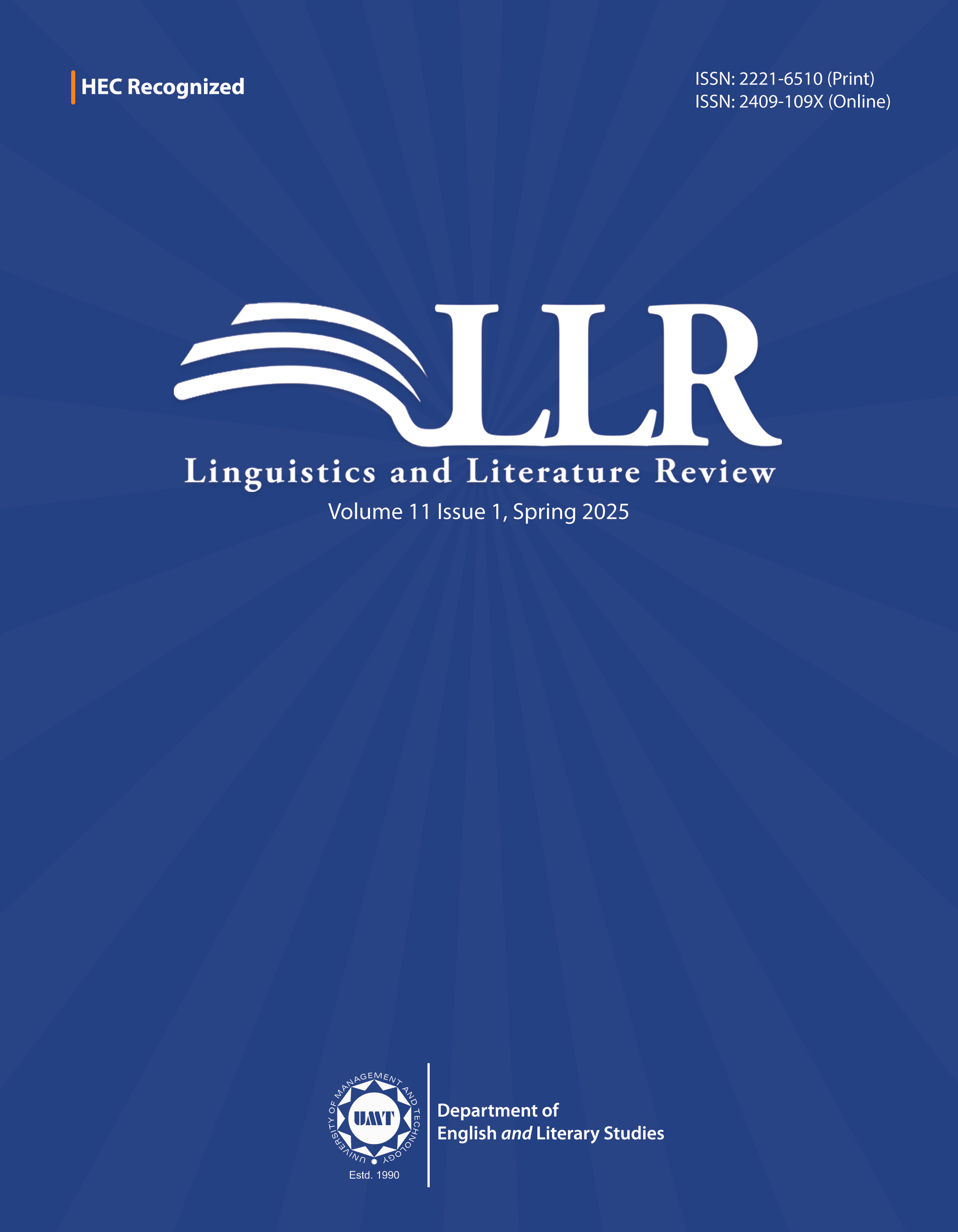Projection of Ideology in Pakistani Advertisements: A Multimodal Critical Discourse Analysis
Abstract
 Abstract Views: 0
Abstract Views: 0
This study aims at investigating the hidden ideology present in the selected advertisement for the audience. Online advertisements are a part of everyday observations. The advertisements used semiotic modes and discourse to convey their message. The study investigates it through the multimodality theory of Kress and Leeuwen (2006a). The sample comprising TRESemme digital advertisement is selected through purposive sampling. The research examines the semiotic modes of the angles of shots through proximal space, as well as the role of vectors, salience, and implied ideology. It analyses the ideology projected in Pakistani digital advertisements along with the embedded theme of You Attitude. The results reveal that the sample advertisement displays implied ideology to dominate the audience through power display. The conveyed meaning persuades the audience to long and aspire for the advertised products and then act upon their desires. The results explicate that the discourses generated through advertisements can be comprehensively explained through semiotic and discursive analysis.
Downloads
References
Abed, A. Q., & Al-Munshy, B. A. (2017). A multimodal critical discourse analysis of the front cover in selected Arab women magazines. Journal of the College of Basic Education, 23(99), 23–44. https://doi.org/10.35950/cbej.v23i99.6545
Adham, S. A. (2012). A semiotic analysis of the iconic representation of women in the Middle Eastern media [Master’s thesis, University of Birmingham]. Docslib. https://docslib.org/doc/4262571/a-semiotic-analysis-of-the-iconic-representation-of-women-in-the-middle-eastern-media
Ahmad, M., Ahmad, S., Ijaz, N., Batool, S., & Abid, M. (2015). Working of ideology in the TV commercials of cold drinks in Pakistani media. Advances in Language and Literary Studies, 6(2), 247–260.
Anderson, P. V. (2016). Technical communication: A reader centered approach (9th ed.). Cengage Learning.
Arens, W. F., & Weigold, M. F. (2017). Contemporary advertising and integrated marketing communications. McGraw-Hill Education.
Ayoola, M. O. (2013). An interpersonal metafunction analysis of some selected political advertisements in some Nigerian newspapers. International Journal of Humanities and Social Science, 3(8), 165–178.
Benveniste, E. (1971). Problems in general linguistics (M. E. Meek, Trans.). University of Miami Press.
Bhatti, Z. I., Nijabat, A., & Khan, A. (2020). An analysis of Pakistani advertising discourse (TV Commercials). Elementary Education Online, 19(3), 2998–3008.
Bovée, L. C., & Thill, V. J. (2018). Business communication today (14th ed.). Pearson.
Brown, A. (2019). Ideology and political culture. In S. Bialer (Ed.), Politics, society, and nationality inside Gorbachev's Russia (pp. 1–40). Routledge.
Crystal, D. (2003). English as a global language (2nd ed). Cambridge University Press.
Dumoulin, J. (2021). Ideology: Where does it come from and how is it used. Academia Letters, Article e391. https://doi.org/10.20935/AL391
Dyer, G. (2008). Advertising as communication. Routledge.
Fairclough, N. (1992). Language and power. Longman.
Fine, G. A., & Sandstrom, K. (1993). Ideology in action: A pragmatic approach to a contested concept. Sociological Theory, 11(1), 21–38. https://doi.org/10.2307/201978
Gay, L. R., Mills, G. E., & Airasian P. (2011). Educational research: Competencies for analysis and applications (10th ed). Pearson.
Gündüz, U. (2017). The effect of social media on identity construction. Mediterranean Journal of Social Sciences, 8(5), 85–92. http://dx.doi.org/10.1515/mjss-2017-0026
Guo, F., & Feng, X. (2017). A Multimodal discourse analysis of advertisements-Based on visual grammar. Journal of Arts and Humanities, 6(3), 59–69.
Hall, E. T. (1966). The hidden dimension. Anchor.
Hassan, A. (2018). Language, media and ideology: Critical discourse analysis of Pakistani news bulletin headlines and its impact on viewers. Sage Open, 8(3), 1–15. https://doi.org/10.1177/2158244018792612
Jewitt, C. & Oyama, R. (2001). Visual meaning: A social Semiotic approach. In T. V. Leeuwen & C. Jewitt (Eds.), Handbook of visual analysis (pp. 134–156). Sage Publications.
Kang, K. D. (2018). Language and ideology: Althusser's theory of ideology. Language Sciences, 70, 68–81. https://doi.org/10.1016/j.langsci.2018.06.008
Kress, G. & Leeuwen, T. V. (2006b). Visual interaction. In A. Jaworski & N. Coupland (Eds.), The discourse reader (2nd ed., pp. 362–384). Routledge.
Kress, G., & Leeuwen, T. V. (2006a). The grammar of visual design (2nd ed). Routledge.
Machin, D. (2007). Introduction to multimodal analysis. Bloomsbury Academic.
Saeed, L., & Khan, S. I. (2022). Critical discourse analysis of language and visuals in beauty advertisements. Global Digital & Print Media Review, 5(2), 37–43. https://doi.org/10.31703/gdpmr.2022(V-II).04
Social Research Association. (2003). Ethical guidelines. https://the-sra.org.uk/SRA/SRA/Ethics/Research-Ethics-Guidance.aspx
Sofia, K. (2015). Advertising as discourse: A study of print advertisements published in the new yorker. Digitala Vetenskapliga Arkivet. https://www.diva-portal.org/smash/record.jsf?pid=diva2%3A840756&dswid=-8058
Spicker, P. (2007). Research without consent. Social Research Update, (51), 1–4.
Sriratu, V. N. (2016). A case study of Multimodal analysis: The representation of a female model in the ‘Insight ’Rubric of male magazine 147th Edition [Doctoral dissertation, Universitas Pendidikan Indonesia]. UPI Repository. http://repository.upi.edu/23707/
Therborn, G. (1980). The ideology of power and the power of ideology (Vol. 24). Verso.
Thompson, G., & Alba-Juez, L. (Eds.). (2014). Evaluation in context. John Benjamins.
Threadgold, T. (1986). Semiotics-ideology-language. Sydney Studies in Society and Culture, 3, 15–60.
van Dijk, T. A. (2011). Introduction: The study of discourse. In T. A. van Dijk (Ed.), Discourse studies: A multidisciplinary introduction (pp. 379–403). Sage Publications
Williamson, J. (1978). Decoding advertisements (Vol. 4). Boyars.
Zhang, C. (2017, October 17–18). Multimodal discourse analysis of advertising language [Paper presentation]. 4th International Conference on Education, Language, Art and Intercultural Communication (ICELAIC 2017), Moscow, Russia.
Copyright (c) 2025 Dr Tabassum Saba, Aimen Kashif

This work is licensed under a Creative Commons Attribution 4.0 International License.

This work is licensed under a Creative Commons Attribution 4.0 International License. Authors retain copyright and grant the journal right of first publication with the work simultaneously licensed under a Creative Commons Attribution (CC-BY) 4.0 License that allows others to share the work with an acknowledgment of the work’s authorship and initial publication in this journal.







